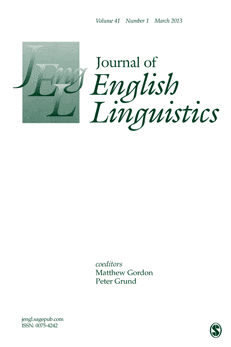
JOURNAL OF ENGLISH LINGUISTICS
Scope & Guideline
Advancing the Frontiers of English Linguistics
Introduction
Aims and Scopes
- Sociolinguistic Variation and Identity:
The journal frequently explores how sociolinguistic factors such as race, class, and regional identity shape language use and variation within English-speaking communities. - Historical Linguistics and Language Change:
A significant focus is placed on the diachronic study of English, examining how the language has evolved over time and the mechanisms driving these changes. - World Englishes and Contact Linguistics:
The journal addresses the dynamics of English as it interacts with other languages and cultures, particularly in postcolonial contexts, showcasing the emergence of new varieties. - Pragmatics and Discourse Analysis:
Research often delves into pragmatic aspects of English, analyzing how meaning is constructed in context and the role of discourse markers in communication. - Cognitive and Experimental Linguistics:
The journal includes studies that investigate cognitive processes underlying language use, often employing experimental methodologies to understand linguistic phenomena. - Language and Power Dynamics:
Themes of power, identity, and linguistic justice are explored, particularly in relation to marginalized communities and the socio-political implications of language use.
Trending and Emerging
- Sociophonetics and Identity:
Recent publications have increasingly focused on sociophonetic properties of English, particularly how they intersect with issues of race, identity, and community, highlighting the importance of accent and variation. - Language and Social Justice:
There is a growing emphasis on linguistic justice, exploring how language intersects with issues of race, identity, and power dynamics, particularly in marginalized communities. - Impact of Political Ideology on Language Use:
Studies examining the effects of political ideology on language variation and change have gained traction, reflecting broader societal concerns and the role of language in political discourse. - Pragmatic Variation in Different Contexts:
Research exploring pragmatic aspects of language, including discourse analysis and the role of context in meaning-making, has become increasingly prominent. - The Evolution of World Englishes:
The journal is seeing a rise in articles discussing the emergence and characteristics of new varieties of English globally, emphasizing the impact of globalization and cultural exchange on language.
Declining or Waning
- Traditional Grammatical Studies:
There appears to be a marked reduction in papers focusing solely on traditional grammatical analyses devoid of sociolinguistic or contextual considerations, indicating a shift towards more integrated approaches. - Narrowly Defined Dialect Studies:
Research specifically centered on narrowly defined regional dialects without broader implications or connections to sociolinguistic trends is becoming less frequent. - Historical Linguistics in Isolation:
While historical linguistics remains a key area, studies that do not connect historical changes to contemporary sociolinguistic contexts are appearing less often. - Descriptive Analyses without Sociocultural Contexts:
There is a noticeable decline in purely descriptive studies that fail to engage with the sociocultural implications of language use, suggesting a move towards more applied linguistic research. - Linguistic Theory without Empirical Data:
Papers relying heavily on theoretical frameworks without substantial empirical backing or data analysis are becoming less common, reflecting a trend towards data-driven research.
Similar Journals

REVUE DE LINGUISTIQUE ROMANE
Illuminating the Rich Tapestry of LanguageREVUE DE LINGUISTIQUE ROMANE, published by the esteemed SOCIÉTÉ LINGUISTIQUE ROMANE, is a prominent academic journal dedicated to the exploration of Romance linguistics. With its ISSN 0035-1458, the journal plays a significant role in advancing knowledge within the fields of linguistics and the history and philosophy of science. Although it does not currently offer Open Access, it provides critical insights and peer-reviewed research that are indispensable for scholars, educators, and students interested in the nuances of Romance languages. The journal, which has seen converged coverage from 2006 to 2017, and then again from 2019 to 2021, is ranked in the third quartile (Q3) across various categories within Scopus, reflecting its established presence in the academic community. As a vital resource for interdisciplinary studies, REVUE DE LINGUISTIQUE ROMANE is instrumental for those seeking to deepen their understanding of linguistic structures, cultural nuances, and the historical development of Romance languages.
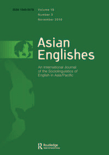
Asian Englishes
Advancing Understanding of Linguistic Diversity Across AsiaAsian Englishes, published by Routledge Journals, Taylor & Francis Ltd, is a leading journal in the field of linguistics and language studies, showcasing diverse English varieties across Asia and their socio-cultural contexts. With an impressive impact factor, it ranks in the Q1 category for both Linguistics and Language disciplines, reflecting its exceptional contribution to the academic community. The journal serves as a vital platform for researchers, professionals, and students who seek to explore the complexities and evolving nature of English usage in Asian settings, providing insightful analyses and fostering scholarly discourse since its inception in 1998. Although not an open-access journal, Asian Englishes is highly regarded in prominent databases such as Scopus, where it ranks in the 90th percentile across multiple categories. The journal's commitment to advancing knowledge in language variation and change remains central to its objectives, making it an essential resource for those dedicated to understanding the dynamics of English in Asian contexts.
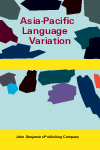
Asia-Pacific Language Variation
Bridging Cultures Through Linguistic ExplorationAsia-Pacific Language Variation is a prominent scholarly journal published by John Benjamins Publishing Co, dedicated to the exploration and analysis of linguistic diversity across the Asia-Pacific region. With its ISSN 2215-1354 and E-ISSN 2215-1362, the journal serves as a key resource for researchers and practitioners in the fields of linguistics and language studies. Since its inception in 2019, it has quickly ascended in stature, receiving a 2023 category quartile ranking of Q2 in Linguistics and Language and achieving impressive Scopus rankings, placing it in the 83rd percentile in Arts and Humanities and 81st in Social Sciences. Through its rigorous peer-reviewed articles, the journal aims to foster a deeper understanding of language variation, promoting interdisciplinary research and collaboration. Although it is not an open-access journal, the depth of research and critical insights offered in its pages make it an invaluable asset for academics, students, and professionals keen on the nuances of language within the dynamic Asia-Pacific context.

Verba-Anuario Galego de Filoloxia
Connecting Academia: Your Gateway to Linguistic InsightsVerba-Anuario Galego de Filoloxia is a prominent academic journal published by UNIV SANTIAGO COMPOSTELA, dedicated to advancing the field of linguistics and language studies. Hailing from Spain, this journal provides a vital platform for researchers, educators, and students interested in Galician philology and its broader linguistic implications. Although it operates under traditional access models, the journal’s commitment to quality research is reflected in its categorization within Q3 in Linguistics and Language for 2023, showcasing its significant contributions to the field. Encompassing a convergence period from 2017 to 2024, Verba garners attention in both the Arts and Humanities and Social Sciences domains, with its Scopus rankings highlighting its moderate impact within these categories. By nurturing scholarly dialogue and disseminating innovative studies, Verba-Anuario Galego de Filoloxia plays a crucial role in promoting linguistic research, making it an essential resource for professionals and academic institutions striving to explore the complexities of language and philology.
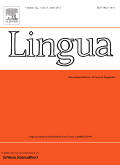
LINGUA
Shaping the future of linguistic exploration and analysis.LINGUA is a premier academic journal dedicated to the field of linguistics, published by ELSEVIER and based in the Netherlands. With an ISSN of 0024-3841 and an E-ISSN of 1872-6135, this esteemed journal has garnered a reputation for excellence, evidenced by its position in the top Q1 quartile in Linguistics and Language as of 2023. LINGUA serves as a vital platform for scholars, researchers, and students, showcasing innovative research and critical discussions across various linguistic subfields. The journal has demonstrated impressive Scopus rankings—151 out of 1088 for Language and Linguistics, and 176 out of 1167 in Social Sciences—placing it in the 86th and 84th percentiles, respectively. By providing a forum for the dissemination of advanced linguistic theories and their applications, LINGUA continues to significantly contribute to the academic community, making it an essential resource for anyone engaged in the study of language.
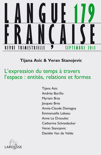
LANGUE FRANCAISE
Fostering Innovation in Language ResearchLANGUE FRANCAISE, published by LAROUSSE, stands as a premier journal in the realm of linguistics and language studies, boasting an impressive Q1 quartile rating in the 2023 Linguistics and Language category. With its international reputation anchored in France, this journal presents critical research and discussions that advance our understanding of the French language, its structures, usage, and evolution. Although not an open-access publication, LANGUE FRANCAISE is indexed with an ISSN of 0023-8368 and an E-ISSN of 1957-7982, reflecting its scholarly credibility and impact, including Scopus rankings that place it competitively in the fields of arts and humanities as well as social sciences. This journal serves as an essential resource for researchers, practitioners, and students aiming to deepen their knowledge and engage in scholarly debates that shape contemporary linguistic thought. The journal's commitment to high-quality research continues to foster an enriching academic environment and contribute to the dynamic discourse surrounding language and linguistics.
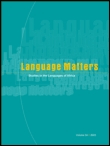
Language Matters
Transforming Perspectives on Language AcquisitionLanguage Matters is a prestigious journal dedicated to the dynamic field of Linguistics and Language, published by Routledge Journals, Taylor & Francis Ltd in the United Kingdom. With an ISSN of 1022-8195 and an E-ISSN of 1753-5395, this journal serves as an essential platform for scholars seeking to explore the multifaceted relationships between language and society. Recognized in the 2023 Category Quartiles as Q2 in Linguistics and Language, it boasts impressive Scopus rankings, sitting at #298 out of 1088 in the Arts and Humanities category and #356 out of 1167 in Social Sciences, highlighting its significant impact on the field with a 72nd and 69th percentile ranking, respectively. The journal's scope encompasses a wide range of topics including language acquisition, sociolinguistics, and psycholinguistics, making it a vital resource for researchers, educators, and students alike. By not offering open access, it maintains a curated selection of high-quality peer-reviewed articles, ensuring that academic rigor and relevance are upheld for its readership. With a publication range spanning from 1993 to 2024, Language Matters continues to shape conversations and advance knowledge in the ever-evolving landscape of linguistic research.

Estudios de Linguistica-Universidad de Alicante-ELUA
Exploring New Horizons in Linguistics from AlicanteEstudios de Linguistica-Universidad de Alicante-ELUA is a distinguished academic journal dedicated to advancing the field of linguistics, published by Universidad de Alicante. With an Open Access model adopted since 2020, ELUA facilitates greater accessibility to pioneering research for scholars and enthusiasts alike. The journal's ISSN is 0212-7636 and its E-ISSN is 2171-6692, ensuring it is indexed and easily discoverable in academic databases. Though the journal's H-Index is currently not specified, its commitment to disseminating high-quality linguistics research positions it as a valuable resource for researchers, professionals, and students. The journal aims to foster scholarly dialogue and innovation in various linguistic domains, making it an essential platform for sharing insights and findings that shape contemporary linguistic studies. Based in Alicante, Spain, ELUA is poised to contribute significantly to the global linguistics landscape.
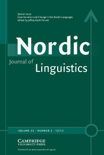
Nordic Journal of Linguistics
Illuminating linguistic diversity and theory since 1978.Nordic Journal of Linguistics, published by Cambridge University Press, serves as a prominent platform for the dissemination of cutting-edge research in the field of linguistics. Established in 1978 and spanning over four decades, the journal has curated a rich repository of scholarly work that reflects the dynamic and evolving nature of language studies. With an impressive Q2 ranking in both the Linguistics and Language category and a commendable performance in Scopus rankings, placing it at the 74th percentile among Arts and Humanities, the journal is recognized for its high academic standards and impact on contemporary linguistic research. Scholars and practitioners can access a variety of studies that delve into different languages, linguistic theories, and methodologies, fostering broader understanding and dialogue within the linguistic community. Although the journal does not currently offer open-access options, it remains an invaluable resource for researchers, professionals, and students keen on advancing their knowledge of language and linguistics.
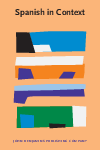
Spanish in Context
Unveiling the Nuances of Spanish in a Global ContextSpanish in Context, published by John Benjamins Publishing Co, is a leading journal in the field of linguistics and literature, focusing on the contexts and uses of the Spanish language. With an ISSN of 1571-0718 and an E-ISSN of 1571-0726, this reputable journal has established itself as an essential resource for researchers, professionals, and students alike since its inception in 2004. The journal enjoys a strong presence in academic discourse, holding a prestigious Q2 category ranking in Linguistics and Language, and an esteemed Q1 ranking in Literature and Literary Theory for the year 2023. Furthermore, its contributions to the field are underscored by impressive Scopus rankings: it occupies the 40th position in the Arts and Humanities category for Literature and Literary Theory, representing the top 96th percentile. With an ongoing commitment to advancing scholarship and understanding of Spanish in various contexts until 2024, the journal welcomes original research articles, reviews, and critical essays that delve into linguistic innovations and literary trends. By fostering a dynamic dialogue among academics and practitioners, Spanish in Context plays a vital role in enhancing the visibility and relevance of Spanish studies on a global scale.